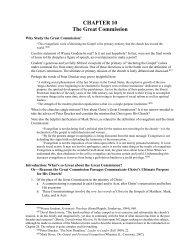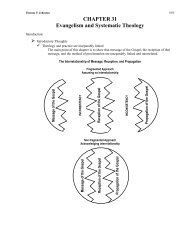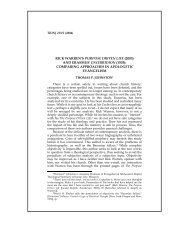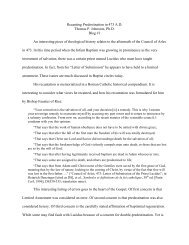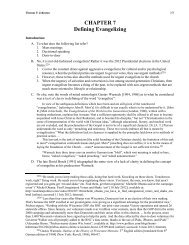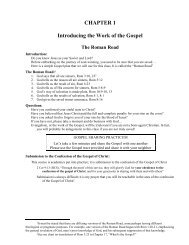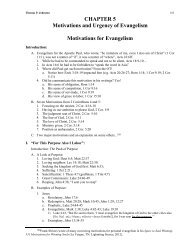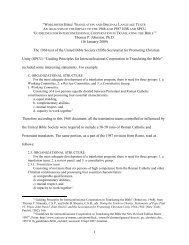Four Categories of Evangelism Programs - Evangelism Unlimited
Four Categories of Evangelism Programs - Evangelism Unlimited
Four Categories of Evangelism Programs - Evangelism Unlimited
Create successful ePaper yourself
Turn your PDF publications into a flip-book with our unique Google optimized e-Paper software.
Soteriology<br />
Thomas P. Johnston 1033<br />
Considerations Conservative Evangelical Possibly “Moderating” Evangelical<br />
Atonement<br />
Conversion<br />
<strong>Evangelism</strong><br />
Tend to emphasize almost uniquely the Substitutionary<br />
Atonement (aka. judicial or forensic atonement)<br />
Tend to emphasize the new birth as a complete change in<br />
nature, including making less <strong>of</strong> a distinction between a<br />
convert, a Christian, and a disciple <strong>of</strong> Christ<br />
Tend to emphasize New Testament evangelism (initiative<br />
and expectant)<br />
Tend to emphasize a Reconciliation or Relational model <strong>of</strong><br />
the atonement, with a life here-and-now emphasis in a<br />
theology <strong>of</strong> salvation (a type <strong>of</strong> middle view between the<br />
objective and subjective atonement)<br />
Tend to emphasize pre-evangelism, pre-discipleship, the<br />
discipleship process, spiritual disciplines, and sometimes<br />
a gradual enlightenment approach to salvation, including<br />
sometimes making a big distinction between a convert<br />
and a disciple<br />
Tend to emphasize culturally “relevant” methods <strong>of</strong><br />
evangelism, including but not limited to friendship,<br />
lifestyle, service, and apologetic evangelism (all <strong>of</strong> which<br />
have ranges <strong>of</strong> definition and application)<br />
Could it be that actual doctrinal changes in actuality start at the bottom <strong>of</strong> the chart and move their way up to the<br />
top?<br />
It is very unlikely that one would move from a “Moderating” position to the “Conservative” view, outside <strong>of</strong> revival.<br />
Water tends to flow downstream. Changes in the other direction, from “Conservative” to “Moderating,” are so commonplace<br />
that they tend to be seen as the norm by those who accept the premise <strong>of</strong> change.<br />
Further difficulty comes from several additional factors: (1) Those who have so changed seek to guise their change,<br />
at least for a while, so as not to lose their positions <strong>of</strong> leadership or their prominence. Similarly, they know how to speak<br />
to keep their “Conservative” constituencies at ease. Therefore they can <strong>of</strong>ten lead seminaries, denominations, and<br />
movements to change with them. (2) The changes themselves are incremental, taking place over a period <strong>of</strong> time, and<br />
are <strong>of</strong>ten very difficult to judge. (3) Those who go through these changes are usually good people with a good history<br />
and a good track record.



